In April 2023 we took a package tour to South Africa with our friends Craig and Sonia. We flew via Singapore to Cape Town.
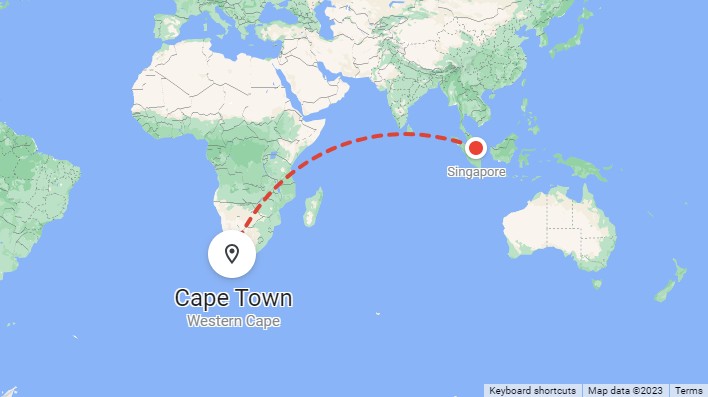
Cape Town is the country's legislative capital and location of the South African Parliament.
It's long been renowned for Table Mountain, that dominates the city.

Our tour included a bus trip out, along the western beaches, to the southern tip of Africa - Cape Point - The Cape of Good Hope - and the historic lighthouse there. Wildlife included several ostriches and the ever-present baboons. We also called in at a penguin colony and the very impressive botanic gardens.

The botanic gardens revealed - not for the last time - the close historical connection between South Africa and Australia, as the first Europeans in Australia generally came this way and picked up plants for their gardens and for agriculture on the way. And, of course: sheep, horses and cattle.

Later, the connection was strengthened by the Boer War, participation in which was the first time that British troops were identified separately as Australian (including New Zealand), an important political step leading to Australian Federation in 1901. In that event, New Zealand failed to to become part of the Federation and became a separate country. The Australian Constitution still leaves joining an option open to them.
The Australians, like the Boer, were admired for their horsemanship and consequent ability to play the Boer guerrillas at their own game. The film 'Breaker Morant' recalls a series of incidents during that war.
That war was interesting, on several other grounds. Most importantly, it had its roots in slavery.
The early settlers the (Dutch) Boer farmers insisted, as had the farmers in the southern states of the USA, that their slaves were essential to commercial agriculture. But 1834 Britain abolished slavery throughout the Empire. So the Boer rebelled against 'Imperial interference'.
In 1867, diamonds were discovered near Kimberley in what is today known as the Northern Cape. Now, additional central African workers needed to be imported as the small indigenous 'bushmen' were thin on the ground and/or unwilling or unable to undertake heavy work. Today, Bushmen remain a small minority, distinguished by their 'click' language.
These grievances festered, culminating in the First Boer War in 1880-81. Using 'guerrilla tactics' the Boer side won. A compromise was reached with the British in which former slaves became 'black workers', yet remained strictly segregated.
In 1886 the discovery of gold near Johannesburg had resulted in a large number of 'foreigners' flooding in, unrestricted by the British. Now many more central African workers were required to mine gold.
This strict racial segregation became codified after an incident at Pietermaritzburg in 1893, when a young Indian lawyer, later to be known as Mahatma Gandhi, was thrown out of a 'whites only' carriage on a train. The highly indignant Gandhi, who was from a noble family and had recently gained his law degree in London, then campaigned, successfully, for a legally defined 'coloured' class to share many 'white' privileges. This experience was formative and lessons learnt were later useful in his, eventually successful, campaign to expel the British from India.
The Boer were not happy either and in 1899 the Second Boer War erupted. After three years of fighting the Boer capitulated.
The Second Boer War was a formative was a experience for Winston Churchill, who was a war correspondent in South Africa. Although nominally a non-combatant, in 1899 he joined an armed attempt to rescue a train under attack. Churchill was captured and spent three months as a Boer prisoner of war, before he managed to escape.
Simultaneously, the experiences of Rudyard Kipling who also covered the Boer War as a newspaper correspondent, contributed to this later founding of the Scouting movement.
After the war the economy grew to be the wealthiest in Africa, while the segregated black African population numbers exploded as immigrants from elsewhere in Africa joined an ever growing domestic population in 'townships'.
In 1947 my English parents, who were considering South Africa as a possible new home, chose Australia instead, after listening to short-wave radio stations in each country. Growing racial tensions in South Africa decided the issue.
In 1948 'Apartheid' was constitutionalised, to international condemnation, except by some prominent politicians in the American south.
It was this Apartheid that eventually led to the country's expulsion from the British Commonwealth, in 1961.
***
Back to the package tour:
Table mountain was not included in the pre-paid agenda so we got a cab and did out own thing, encountering several others from our group.

One can go up using the cable car and descend another way but we had already paid for a return journey so, decided not to take one of the other ready options. One is much slower than the other, as it employs a rope to moderate one's descent.

On our way back from the cable car we stopped off at Bo-Kaap, at the foot of Signal Hill.
Here a small section of historic workers cottages, in what was once the Muslim sector, have been dressed up as a tourist attraction.
While there, we wanted water and went to a corner store to buy some. The little store, selling nothing but the usual groceries, had a very substantial steel gate, befitting a prison, and we had to be buzzed in and out!
Down the street, some women were flouncing around in colourful dresses, we assumed for a wedding or a photo-shoot. But "no," they told us, "we're just having fun". They were happy to pose for us.

In the evening we returned to the harbour retail area, where a local choir/dance group was performing. It was Sunday so possibly it's a religious group? We had no idea what they were singing. It sounded a bit like: Hasa Diga Eebowai from the 'Book of Mormon'?
There's no shortage of fun in Cape Town.
The city is, nominally, similar in population numbers to Sydney but the CBD is noticeably smaller and although some suburbs are strikingly similar, the high quality dwellings do not compare to Sydney's, in number or spread but we discovered, in a local real estate window, that R12,000,000 (A$ one million) will buy you an 8 bedroom boutique guesthouse on a couple of acres in a safe area near Stellenbosch.
The next day we set out for Stellenbosch passing kilometre after kilometre of settlement chanties, in which something like two thirds of the population lives. They were expanding, at the fringes, before our eyes.

At Stellenbosch, we were staying out of town, in the countryside. It was quite idyllic, except that we couldn't walk outside the estate perimeter due to the electric fences. They were not there to contain the animals nor the guests. They're simply a feature of middle class life in South Africa.
Almost the first thing one notices about middle class residences in South Africa is the, almost ubiquitous, electric fences and barbed wire.
I asked our driver what happens when someone shorts-out a fence, which would seem to be easy to do. Anything insulated would do. Just push the alternate wires together - a wine bottle would be ideal.
He said no, no one goes near them. Too Scary! I was so tempted to see for myself. Some have signs saying: 'Armed Response' - but how quickly? A hidden machine gun?
The fences separate two worlds: an Australia-like one (very similar in almost every way); and that of the settlements - many are un-serviced shanty towns.
These are growing all the time, new ones going up as we passed, because however terrible and unsanitary they are, they are better than elsewhere in Africa, where new people flood in from, every day.
As my parents asked over 70 years ago - how long can this go on?

Stellenbosch is a pleasant middle-sized city/town about an hour's drive from Cape Town, in the heart of the wine country. It's quite similar to several of Australia's larger regional towns and about as ethnically diverse.
Stellenbosch boasts a University; a coffee/wine culture, with a plethora of cafés and restaurants; and a growing tourist industry. It's architecture is 'Cape Dutch', having been founded by Simon van der Stel in 1679 (Stel's Bush).
As the date attests they were producing wine here before European settlement in Australia was even thought of. Of course, after 1787, all the British convict fleets came this way, enroute to Sydney Town, to pick up livestock and other provisions, not to mention rum (a generic term that included wine and brandy).
Over 70% of the population have Afrikaans as their first language but everyone we encountered also speaks English.
This was the first time I noticed that both Australians and South Africans use 'the bush' to denote the countryside. Why don't we use the more English 'forest' or 'countryside, like New Zealand'? The word 'bush' was adopted very early, obviously preceding the term: 'bushranger', instead of 'highwayman'.
Macquarie Dictionary tells me that its origin is: [Middle Dutch busse (noun)]. So, obviously, Australia got it from here.
If you are like me, you were never taught any South African history at school, except for acknowledging the heroes of the Boer War, listed on numerous honour boards and memorials.
This is the official government (short) version: Click here... Nothing about those heroes here. History is written by the victors, very interesting.
According to our walking tour guide in Stellenbosch, the metallic signs and lettering on several shops and buildings had disappeared overnight. No doubt during the blackout.
We had initially expected a trip on the luxury Blue Train as a component of our tour package. Here, we were told that the reason the Blue Train wasn't running was because the copper cables had been stolen. A Facebook friend added that when he lived here a decade ago even the telephone wires got stollen.
Who buys the scrap metal? Later, we imagined that it makes it's way over the border, into Zambia

Our somewhat disgruntled tour group, as a result of missing out on the Blue Train, organised a day trip to the east coast to see a bit more of the Cape.
One of our stops was the pleasant/cute/trendy village of Franschhoek (the French corner, in Afrikaans).
Among the Europeans who settled here were French Protestants, the Huguenot, driven from France during the wars of religion, who now make up a sizable minority in this region.

Below - a local art gallery in Franschhoek and the resort town of Hermanus Village - no doubt nicer on a fine day.
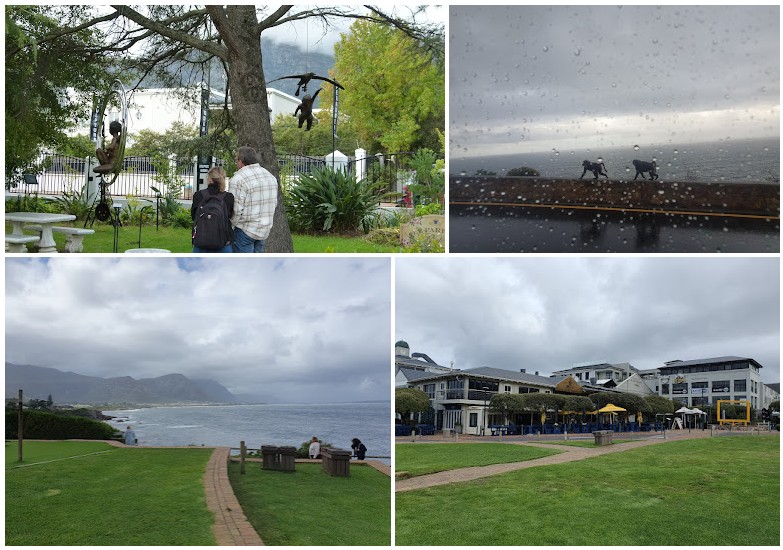
The following day we flew north to Johannesburg.
Johannesburg is South Africa's largest and most commercial city. Yet, we were bound for Pilanesberg and an African safari.

Our overnight billet was the Emperor's Palace casino.
Johannesburg is not considered a safe place to allow tourists, from an organised tour, to roam about and the casino has a high electrified boundary fence and a gate with armed guards.
Notwithstanding, Wendy and I got an Uber to a local shopping mall, where else? I bought the shoes I'm wearing today and Wendy bought some big socks for her son, Heath. In between, we saw some of the city's industrial outskirts and a couple of residential areas. It didn't seem too scary.
The hotel was actually quite nice, if in need of a bit of maintenance: I repaired the flush in one of our (two) loos.
The casino - well what can one say? The gambling hall had an awful lot of poker machines and a few tables for other gamblers. We walked through unscathed several times (no guns). Yet, something strange was going on upstairs that required armed guards who turned us away, rather threateningly, when we followed the signs back to our hotel. We were not about to argue.

I photographed David's back for fans of 'Cunk on Earth':
|
This may seem a bit strange unless you are familiar with the British mockumentary series, staring Diane Morgan as Philomena Cunk, an ill-informed investigative reporter who interviews real experts in their field asking naïve and, sometimes insightful, questions while delivering bizarre observations about human progress with a deadpan delivery.
It's very funny - at least, I find it so. (It's on Netflix - if you are in OZ Click here...) |
Notice the desk at which you need to hand in your guns before entry to the gaming area. South Africa must be one of the few countries in which it is possible for civilians to 'swan about' openly carrying a side arm in a holster.
Our guide said the licencing laws are very strict. They must be - I didn't see a single black person carrying a gun.
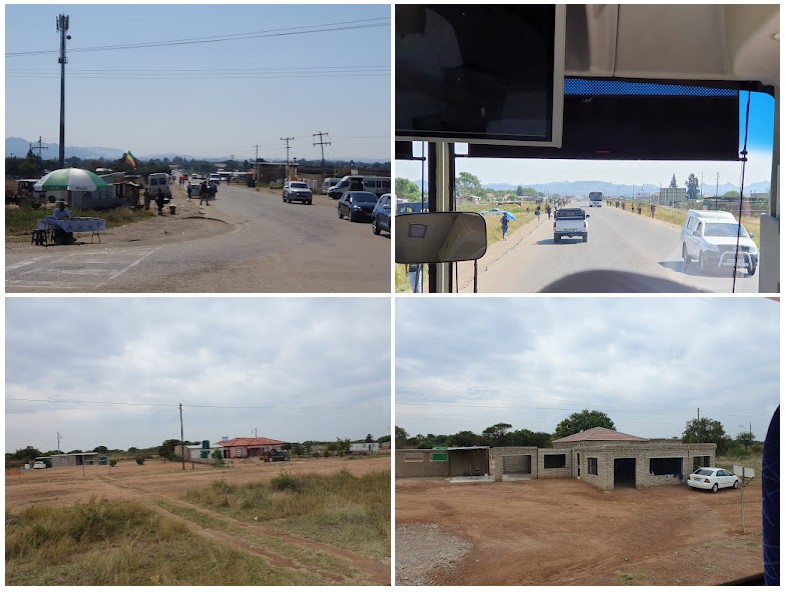
On the coach journey, on our way to go on safari at the Pilanesberg Game Reserve, we passed numerous settlements - some relatively established.
A number were distinguished by very high flood light towers - in lieu of street lights. Many of these were glaring down, in the middle of the day. We guessed that the time-clocks had been disrupted by the frequent electricity blackouts, that now occur, for hours on end, throughout the country.
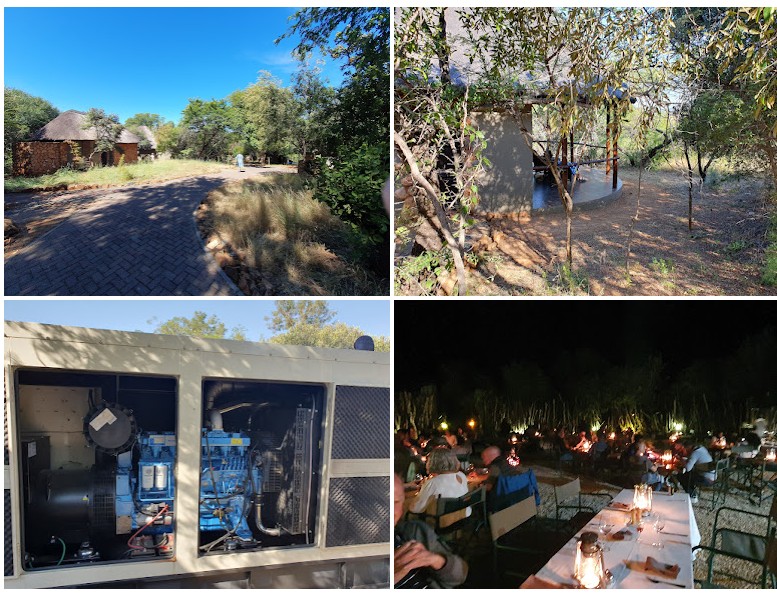
It's well known that South Africa has an electrical energy shortage. They have new wind farms but no where near enough to replace 'old coal'.
As a result, the power often fails during what is euphemistically called 'load-shedding'. Typically around two hours at a time. But in Stellenbosch it was 4 hours one evening.
All the hotels we have stayed in have large diesel generators, that switch in after a few seconds, and the ones at the Ivory Tree Game Lodge run more frequently (as much as half the time). There are a couple of these large, and very noisy, diesel generators that cut-in when the grid fails but these don't always restore electrical services like Wi-Fi, upon which we now depend for everything, it seems.
As I wrote at he time: "These ones are very noisy and one is on now, yet the power and internet are not on in our cabin - presumably to save fuel. They must use a lot and are not at all green. Australia beware."
The Pilanesberg Game Reserve, next door, didn't disappoint. We had early morning and sunset safaris each day, for three days, during which we saw most of Africa's big game and several small ones too. The photos that follow are just a sample.
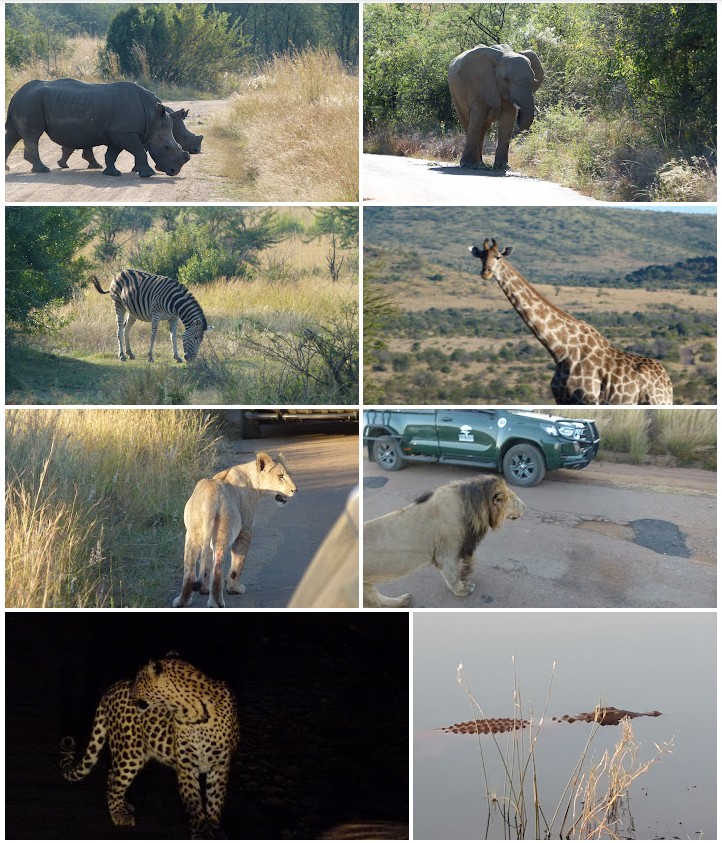
A big Lion seemed to like or suspect Wendy. He looked directly at her.
The car with the other half of our party had a similar experience with a group of elephants that made their way between the cars. We saw lots of elephants but only at a greater distance.
The lions were so frequent; so unafraid; and so disinterested; that they almost became boring. I was tempted to reach out and pet one. Probably not a good idea.
After quite sufficient safaris it was time to fly to Zambia to visit Victoria Falls.

Apparently Victoria Falls have moved. When I was at school they were in Rhodesia, our Imperial cousin, marked in pink on the big world map and remembered, jingoistically, each Empire Day. Since then they've been peripatetic or at the very least, vacillating, between: Zambia and/or Zimbabwe.
Livingstone, in Zambia, is noticeably different to towns in South Africa. It hasn't grown much since 1979.
Much of the infrastructure - including the ever-present electric fences - is in ruin. The town itself is fine but one-time orchards now seem to feed the elephants and we were told that the fences don't stop them. The elephants have learnt to throw a tree branch over the fences to short them out and even brick walls don't stop them.
There's no need to go on safari to see zebra, giraffe, or elephants, not to mention monkeys and baboons, they're wandering along the roadside.

Centre-right (above) is our local zebra that, in the resort minibus, we passed several times.
My joke of the day: "Sometimes he's on one side, sometimes on the other. On the road he's a zebra crossing".
'David Livingston Safari Lodge and Spa' in Zambia, is one of several on the Zambezi River, above Victoria Falls. Our first night we were taken on a river cruise to see some of the wildlife, while enjoying drinks and a light meal.

Out on a river cruise we saw, at last, quite a few hippopotamus (Oh My?), a herd of buffalo, and another crocodile (a small one that had invaded the hotel pond). Walking between resorts signs warn of crocodiles, that might leap out and eat you; and Hippos, that like to kill people for no good reason, as they are vegetarian.
Victoria Falls result when the river plummets into a transverse chasm: Batoka Gorge (1,708 metres wide and 108 metres deep). Due to the unusual geology, the river has eroded, over time, zig-zag fashion, a succession of, almost parallel, trench-like gorges, at the edge of the escarpment.
So, on land, it's not possible to stand sufficiently back to get a panoramic view, as at Iguazu or Niagara. Nor can one approach them from below by boat.
 Source Wikipedia: "Diego Delso, delso.photo, License CC-BY-SA"
Source Wikipedia: "Diego Delso, delso.photo, License CC-BY-SA"
Instead, just over 100 metres in front of the cataract there is a long stretch of land that allows one to see them up-close, from various vantage points, and to get wet from the spray. At one point, a gap is crossed, by a narrow pedestrian bridge, over the 108 metre drop, where one gets very wet indeed. Needless to say, it's not a place for those scared of heights or those worried about aging bridges, in a country not renowned for its ongoing maintenance of Imperial hangovers.
Victoria Falls claim to be the largest in the world. They are roughly twice the height of Niagara Falls and well over twice its width. Yet they are not as impressive as Iguazu Falls, composed of several hundred separate cascades - that's much more spectacular.
Nevertheless, like all great waterfalls, Victoria Falls are awe inspiring. At one point, just above the falls, and meters from the edge, the bank is close to the path and river rushes past close your feet. There's no fence. If there ever was, its probably been swept away.
One false step and: "see you in bits at the bottom".
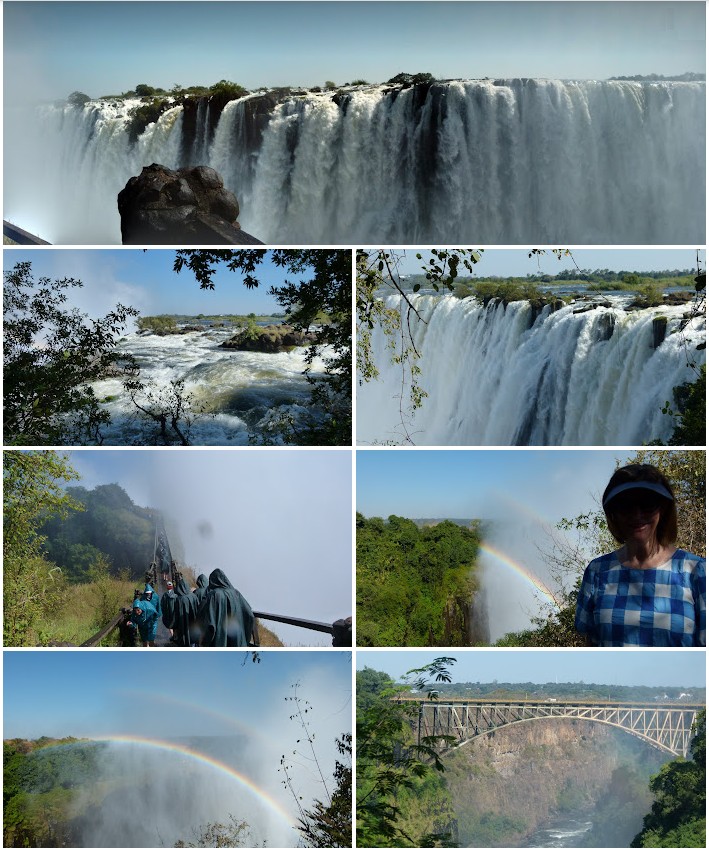
Victoria Bridge (above), another Imperial hangover, is the only crossing, of the 'mighty Zambezi', into Zimbabwe. The little white box in the middle houses the bungee-jumping platform.
Zambia's principal export is copper (metallic copper and copper ore). All these trucks, carrying copper metal, are lined up to cross the Victoria Bridge into Zimbabwe.

Our tour package included a five course gourmet dinner on a luxury train, that would stop on the Victoria Bridge for a unique view of the falls.
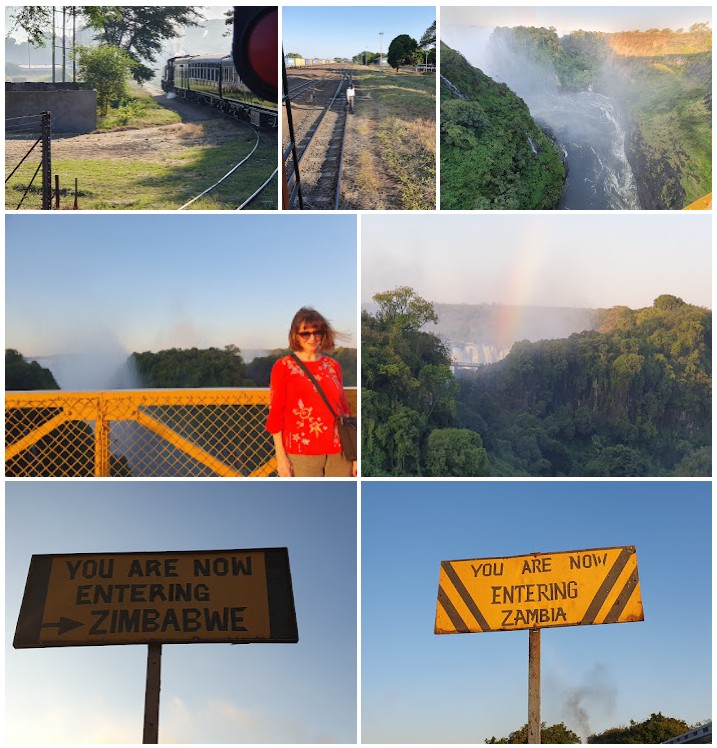
Over Wendy's shoulder you can see the very wet foot bridge that we traversed earlier in the trip and from which I photographed this bridge.
The train turned out to be pulled - or rather pushed by an historic Garratt steam locomotive, once run by Rhodesian Railways. It was beautifully maintained and the meal was excellent, with a bottomless supply of wine and soft dinks.
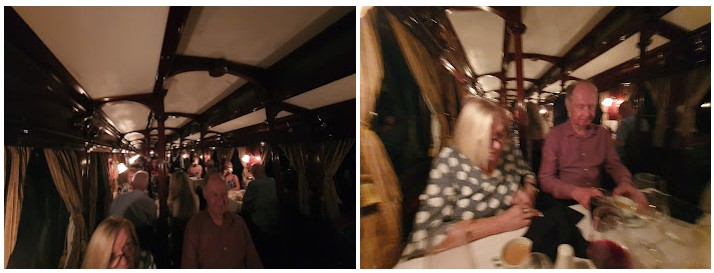 Was it the alcohol or the train shaking when I snapped these photos?
Was it the alcohol or the train shaking when I snapped these photos?
While the train itself was immaculate, the same could not be said for the track and trackside infrastructure, much of which lay in ruins. A small bridge, over a culvert, looked decidedly unsafe and our trainman, who leapt out to change the points, seemed relieved when we got over it.
At one point even the trackside brick walls had collapsed sections and we were told that it was the work of the elephants that wander about.
It was also interesting that the heavy Garratt engine and its accoutrement (tender, etc) stayed firmly on the land, having reversed the lighter carriages onto the bridge.
When I was a boy the NSW Government Railways had a brief romance with Garratts for hauling freight trains and when one passed our Primary School some one would shout 'Garratt' and we would all watch it pass by. So it brought back some fond memories. The line was electrified for suburban trains but the electrification did not extend all the way to Newcastle and, in any case, freight trains were too heavy for electric locos that would draw too much current, they were the days of mercury-arc rectification (before high power silicon semi-conductors).
But coal was soon to be replaced by diesel-electric locomotives.
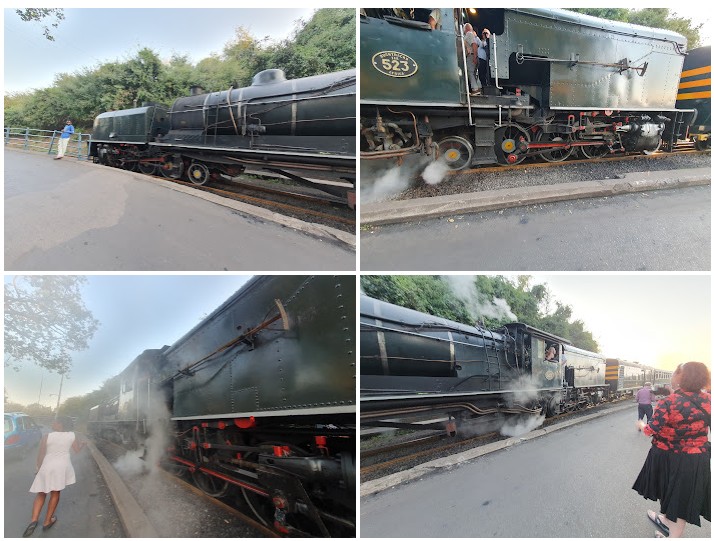
Wikipedia tells me:
Rhodesia imported 246 Garratts of four different wheel arrangements. Many went to Zambia Railways in 1967 when Rhodesia Railways surrendered the lines in Zambia to its government. Zimbabwe's economic and political situation has extended the life of its Garratts.
Later, we crossed into Zimbabwe by bus to the airport, a somewhat fraught experience, on the start of our long journey home.
If you are interested in more photographs or just want to see one in more detail - click on the image below
Click on the image above


